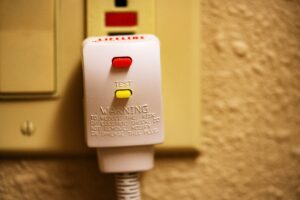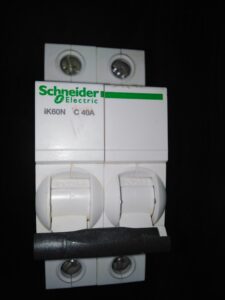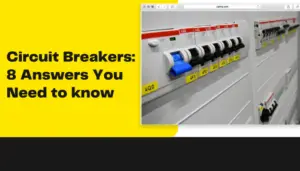Electricity is essential in our daily lives, but it can also be dangerous. Electrical malfunctions and hazards can cause electrical shocks and fires, leading to injuries or even death.
To minimize the risks, we use electrical safety devices such as GFCIs and circuit breakers. Although both are electrical safety devices, they serve different purposes.
In this article, we will explore the differences between GFCIs and circuit breakers, their functions, and when to use them.
Table of Contents
What is a GFCI and how does it work?

Ground Fault Circuit Interrupters (GFCIs) are devices designed to protect people from electrical shock.
They work by sensing any current leakage in the circuit and shutting down the power to prevent electrocution.
GFCIs are installed in electrical outlets, particularly in areas where there is a risk of electrical shock, such as kitchens, bathrooms, and outdoor outlets.
GFCIs are also required by the National Electrical Code (NEC) in all new homes and for upgrades or renovations. Read my article GFCI working principle and testing.
Understanding Circuit Breakers

Circuit breakers, on the other hand, are devices designed to protect electrical systems from overloading or short circuits that can cause electrical fires.
They work by interrupting the electrical current flow when it exceeds the rated amperage. Circuit breakers are installed in the main electrical panel or sub-panels in the home and are responsible for protecting the entire electrical system.
Comparison between GFCIs and Circuit Breakers
Although both GFCIs and circuit breakers are electrical safety devices, they have different functions and operate differently. Here are the key differences between GFCIs and circuit breakers:
- Function: GFCIs are designed to protect people from electrical shock, while circuit breakers protect electrical systems from overloading or short circuits.
- Location: GFCIs are installed in electrical outlets, while circuit breakers are installed in the main electrical panel or sub-panels.
- Sensing mechanism: GFCIs detect ground faults (current leakage), while circuit breakers detect overcurrents.
- Speed: GFCIs respond to a ground fault within milliseconds, while circuit breakers may take longer to trip, depending on the type of fault.
- Resetting: GFCIs need to be manually reset after they trip, while circuit breakers may automatically reset or need to be manually reset, depending on the type of circuit breaker.
When to Use GFCIs and Circuit Breakers
Knowing when to use GFCIs and circuit breakers is essential to ensure electrical safety. Here are some guidelines:
- Use GFCIs in electrical outlets located in areas prone to moisture, such as bathrooms, kitchens, and outdoor outlets.
- Use circuit breakers in the main electrical panel or sub-panels to protect the entire electrical system from overloading or short circuits.
- Use both GFCIs and circuit breakers for added protection in areas where electrical safety is critical, such as swimming pools, hot tubs, and outdoor outlets.
Can I replace a standard outlet with a GFCI outlet?
Yes, you can replace a standard outlet with a GFCI outlet. In fact, in some locations, it may be required by code to install GFCI outlets in certain areas of your home.
A GFCI outlet is designed to protect against electrical shock by detecting any imbalance in the electrical current flowing through it. If it detects a current leakage, it will quickly interrupt the power to the outlet, preventing electrical shock.
To replace a standard outlet with a GFCI outlet, you will need to turn off the power to the outlet at the circuit breaker panel. Then, remove the cover plate and unscrew the mounting screws that hold the old outlet in place. Carefully pull the outlet out of the electrical box and disconnect the wires from the old outlet.
Next, connect the wires to the corresponding terminals on the GFCI outlet. Most GFCI outlets will have a label or instructions on the back that will help you connect the wires correctly.
Once the wires are connected, carefully push the outlet back into the electrical box and secure it in place with the mounting screws. Finally, install the cover plate and turn the power back on at the circuit breaker panel.
It’s important to note that if you are not comfortable working with electrical wiring, it’s best to hire a licensed electrician to do the installation for you to ensure that it’s done safely and correctly.
Conclusion
GFCIs and circuit breakers are essential electrical safety devices that protect people and electrical systems from electrical hazards.
Although they have different functions, both are necessary to ensure electrical safety in your home or workplace.
Comparison Table:
| Criteria | GFCI | Circuit Breaker |
|---|---|---|
| Function | Protects people from electrical shock | Protects electrical systems from overloading or short circuits |
| Location | Installed in electrical outlets | Installed in the main electrical panel or sub-panels |
| Sensing Mechanism | Detects ground faults (current leakage) | Detects overcurrents |
| Speed | Responds to a ground fault within milliseconds | May take longer to trip, depending on the type of fault |
| Resetting | Needs to be manually reset after tripping | May automatically reset or need to be manually reset, depending on the type of circuit breaker |
Install my Free Android App on Google Play:
Electrical Cables Most Common Tables
And, my Electrical Calculations App “”
Discover more great content by subscribing to My channel
Looking to stay ahead of the game in the world of electrical engineering? Subscribe to my YouTube channel and gain access to exclusive content you won’t find anywhere else!
The staff I recommend
(Amazon Affiliate Links to products I believe are high quality):
- Economy 120 Volt/60Hz AC Power Source – Step-Down Voltage & Frequency Converters 1800W
- UNI-T Digital Multimeter Tester UT139C
- 50-Amp Extension Cord for RV “100ft”
- Voltage Stabilizer 110/220v
- Hair Dryer “best selling“
- TOSHIBA EM131A5C-BS Countertop Microwave Ovens
Disclaimer: This contains affiliate links to Amazon products. I may earn a commission for purchases made through these links.


